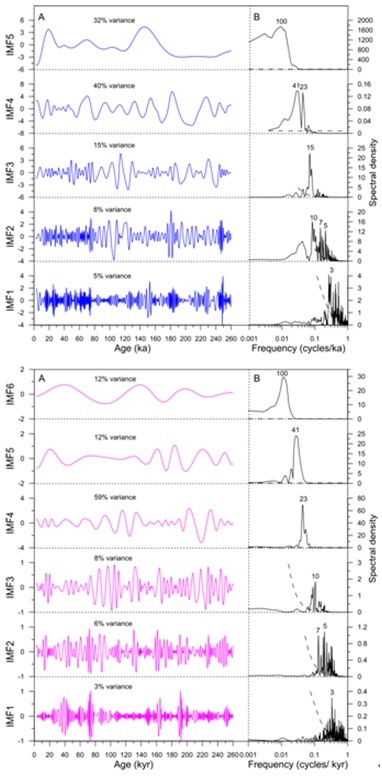The East Asian Monsoon (EAM), as a significant part of Asian monsoon circulation, plays an important role in driving the palaeoenvironmental changes in East Asia. The EAM can be quantified at various time intervals ranging from tectonic to centennial as inferred from loess, speleothem and marine records. However, the relative contributions and plausible driving forces of the monsoon variability at different timescales remain controversial.
Dr. LI Ying and her co-authors conducted a comprehensive investigation of multiscale EAM variability over the last 260 kyr by analyzing the mean grain size record from a Gulang loess sequence and speleothem δ18O record from Hulu and Sanbao caves. The objectives are to evaluate the relative contributions of glacial-interglacial- to millennial-scale signals, and to emphasise the millennial similarity between loess and speleothem records.
Spectral results of these two proxies display clear glacial and orbital periodicities corresponding to ice volume and solar cycles, and evident millennial signals which are in pace with Heinrich rhythm and Dansgaard–Oeschger (DO) cycles. Five intrinsic components are parsed out from loess grain size and six intrinsic components from speleothem δ18O records. Combined signals are correlated further with possible driving factors including the ice volume, insolation and North Atlantic cooling from a linear point of view. The relative contributions of components differ significantly between loess grain size and speleothem δ18O records. Coexistence of glacial and orbital components in the loess grain size implies that both ice volume and insolation have distinctive impacts on the winter monsoon variability, in contrast to the predominant precessional impact on the speleothem δ18O variability. Moreover, the millennial components are evident in loess grain size and speleothem δ18O records with variances of 13 and 17 %, respectively. A comparison of the millennial-scale signals of these two proxies reveals that abrupt changes in the winter and summer monsoons over the last 260 kyr share common features and similar driving forces linked to high latitude Northern Hemisphere climate.
The study has already been published on Climate of the Past (Ying Li, Ninghu Su, Lianji Liang, Long Ma, Yan Yan, and Youbin Sun, 2015, Multiscale monsoon variability during the last two climatic cycles revealed by spectral signals in Chinese loess and speleothem records, Climate of the Past, 11, 1067-1075. Doi: 10.5194/cp-11-1067-2015)
Contact:
LI Ying
State Key Laboratory of Loess and Quaternary Geology, Institute of Earth Environment.
Email: liying@ieecas.cn

Figure 1. IMFs of Gulang mean grain size (above) and speleothem δ18O (below) series and corresponding spectra. Numbers in black are dominant periods and dotted lines represent the 90% confidence level.(Image by LI Ying)

Figure 2. Comparison of millennial-scale variations among Gulang mean grain size (blue), CHILOMOS stack Md (green; Yang and Ding, 2014) and Sanbao/Hulu speleothem δ18O (magenta; Wang et al., 2008; Cheng et al., 2009) records over the last two glacial–interglacial cycles. Cyan dotted lines are the YD and the Heinrich events identified among the three records and gray bars indicate interglacial periods. The numbers represent well-correlated Chinese interstadials identified among the three records. (Image by LI Ying)
 © 2015 Institute of Earth Environment,CAS
© 2015 Institute of Earth Environment,CAS  © 2015 Institute of Earth Environment,CAS
© 2015 Institute of Earth Environment,CAS